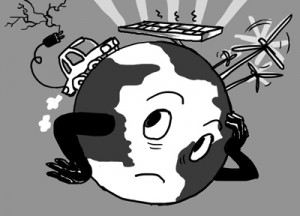Clean energy requires closer analysis
Clean energy has long enjoyed a fairly positive public image. Vague notions that it’s impractical or expensive are generally dispelled by the assurance that it’s the key to our future, will keep our planet healthy, etc.
In recent weeks, however, there’s been an influx of negative publicity for certain forms of clean energy. Fox News happily promoted the inefficiency of electric cars while The Wall Street Journal led a combination expose/crusade against wind energy.
The Washington Examiner also jumped on the tar-and-feathering of the wind turbine, while the generic rumblings that solar power is too expensive got a little louder. Passionate defenses of the electric car and company have poured forth in return, cropping up across the Internet from personal blogs to National Geographic.
Understandably, there’s been some confusion.
It would be easy to brush aside all the criticism with the blanket excuse that conservatives simply badmouth clean energy because they have other priorities. In some cases, this might be true. In others, they’ve actually made some valid points.
ELECTRIC CARS
This is the green initiative that has recently come under the most fire, thanks in part to an Energy Policy paper. The paper contends that in countries already saddled with high levels of CO2, like China, battery powered vehicles have a greater carbon footprint than your standard Hyundai. The publicity that followed got somewhat carried away, claiming that BPVs might actually speed global warming.
The absurdity that allowed the blog to be picked up by everyone from Red Dog Report to Fox News is a little unsettling. The criticism discounted both the significant carbon offsets that electric cars provide in other areas of the world and the fact that they can still be effective in heavily-polluted countries.
Investing in an electric car ultimately comes down to whether or not it’s worth it to you personally. They’re expensive, you can’t buy them used and their safety is somewhat unproven. On the other hand, they’re easily maintained and can come with tax credits in the realm of $7,500.
A BPV’s batteries need to charge for anywhere from six to 12 hours each night, but if we can incorporate our cell phone, iPod, laptop and camera chargers into our daily lives, we can probably work our way around one more.
WIND ENERGY
The Journal’s beef with wind energy had to do with taxpayers kicking in more than they should have to, and with “impatient Democrats” raiding the loans associated with wind energy for other endeavors.
It’s not improbable that the Obama administration’s clean energy budget has its kinks to work out. But that doesn’t entirely discount wind turbines from the clean energy equation.
Wind energy as a whole is not inordinately expensive; according to a 2008 Congressional Research Service report, the price tag is comparable to that of natural gas or coal, and in some cases it’s actually a cheaper alternative.
The problem with wind energy, aside from whatever current pork-barrel scandal is making its way through Congress’ version of the tabloids, is its inconsistency. Without a breeze to ruffle the smog, turbines wouldn’t keep a single city block of Los Angeles going. Given a strong wind, however, the worst that can really be said about turbines is that they’re noisy and might off the occasional passing bird.
SOLAR ENERGY
It’s not a fix-all. Solar panels can run more than $1000 a pop, and they don’t work well in pollution. They’re still fairly efficient, though, and the expense seems clearly worth it in the long run. But they’re not necessarily feasible everywhere; attempting to make them a prominent source of energy in downtown Los Angeles, where you can ask for a smog check with your car wash, might actually not be worth the hassle.
Still, solar energy is an incredibly promising medium for areas in which the panels would function well. And the more we invest in them, the cheaper they’ll eventually become.
Clean energy has its problems — we knew that before Energy Policy told us.
On the whole, the negative publicity isn’t much of a revelation. We know clean energy is expensive, that it can be unreliable and that our government has a long way to go before we could use it on par with natural gas or coal.
That simply leaves us to decide which forms of clean energy, and at what cost, can be efficiently implemented.
The same decisions we’ve been making for years.
Kastalia Medrano is a sophomore majoring in print and digital journalism and associate managing editor for the Daily Trojan. Her column, “Green Piece,” runs Tuesdays.


Booooooooooorrrrrrrring….Yawn
Yes. This is exactly the kind of thought that needs to go into clean energy AND government taxes, welfare, traditional energy- we need to start being conscious all across the board.